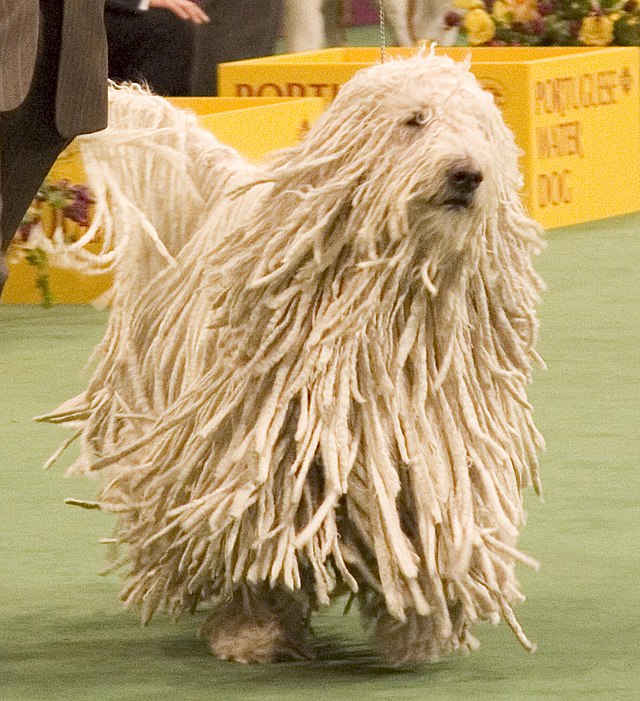


The Komondor is a large, impressive dog known for its distinctive corded coat that resembles dreadlocks. This breed was originally bred to protect livestock, particularly sheep, in Hungary. Known for its protective and loyal nature, the Komondor is both a powerful guardian and a calm, loving companion for the right owner. While it requires a significant amount of grooming due to its unique coat, it is an excellent choice for experienced dog owners who understand the breed's needs.
The Komondor is an ancient breed, with origins dating back more than a thousand years. It was brought to Hungary by the Magyars, who used it to guard livestock from wolves and other predators. The breed was specifically developed to work in harsh conditions, protecting large flocks of sheep in the remote Hungarian countryside. Over the centuries, the Komondor became highly prized for its ability to protect its flock, and its corded coat, which helped it blend in with the sheep, provided both protection and camouflage. Today, the Komondor is still used as a livestock guardian, although it is also kept as a companion and family dog in some homes.
The Komondor is a large, muscular dog that stands between 25 to 30 inches tall at the shoulder and weighs between 80 to 130 pounds, with males generally being larger than females. One of its most distinguishing features is its long, corded coat, which forms natural ropes or "dreads" that protect the dog from harsh weather and potential predators. The coat is thick and white, though it may appear slightly yellowish due to exposure to sunlight. The Komondor has a broad, powerful head with a large, black nose and dark, almond-shaped eyes. Its ears are triangular and slightly floppy, adding to its imposing appearance. Despite its intimidating size, the Komondor has a calm and serene expression. The breed has a strong, muscular body and a thick neck, which contribute to its strength and endurance as a protector.
The Komondor is an incredibly loyal and protective dog, especially when it comes to its family and territory. This breed has a strong instinct to guard and protect, and it is often aloof or reserved around strangers. While it is usually calm and confident, the Komondor can be territorial and might display wariness toward unfamiliar people or animals. Early socialization is important to help the dog differentiate between friend and foe. Despite its guarding nature, the Komondor is affectionate and gentle with its family members, including children. It is known for being patient and tolerant, but its protective instincts can make it an assertive presence in the home. With proper training and socialization, it can be an excellent family companion, although it is best suited for owners who can handle its independent nature and strong-willed temperament.
The Komondor is an active breed that requires regular exercise to stay healthy and happy. While it is not as energetic as some other working breeds, it needs daily walks and time to roam in a safe, enclosed area. The Komondor enjoys having a job to do, so tasks like guarding the yard or participating in activities like obedience training can be good outlets for its energy. The breed is known for its stamina and strength, so it can handle more intense exercise when necessary, but it also enjoys lounging around the house and resting after a workout. Due to its size, it is important to monitor the Komondor’s activity to ensure that it doesn’t become overweight or overly sedentary, which could lead to joint issues in later years.
The Komondor is an independent and intelligent breed, which means that while it is capable of learning quickly, it can also be stubborn and strong-willed. Early training is essential, and owners must establish themselves as the pack leader from the start. Positive reinforcement methods work best, as Komondors are sensitive and respond well to praise and rewards. Socialization should begin as early as possible to help the dog become accustomed to a variety of people, animals, and environments. This is particularly important because of the breed's protective instincts, which can make it wary of strangers. Socializing with other dogs and people will help ensure that the Komondor is confident and well-behaved, reducing the likelihood of overly aggressive tendencies. A firm but gentle approach to training will help the Komondor become a well-rounded and obedient companion.
The Komondor is generally a healthy breed, but like all dogs, it is prone to certain health conditions. Common issues include hip dysplasia, progressive retinal atrophy (PRA), and ear infections due to its large, floppy ears. Regular veterinary checkups are important to catch any potential issues early. Grooming the Komondor requires a significant amount of attention due to its corded coat, which must be maintained to prevent matting. It is recommended to start grooming the dog at a young age to get it used to the process. Brushing the cords and keeping them separated is important, and professional grooming may be needed to maintain the coat’s condition. Additionally, the breed’s ears should be checked regularly and kept clean to avoid infections. Despite its dense coat, the Komondor is relatively low-maintenance when it comes to shedding.
The average lifespan of the Komondor is between 10 and 12 years. With proper care, including a balanced diet, regular exercise, and routine veterinary care, the Komondor can live a long and healthy life. Ensuring that the dog maintains a healthy weight and avoids joint stress through appropriate exercise can help improve its longevity. As with all large breeds, joint health is a priority, so monitoring the Komondor for signs of arthritis or other musculoskeletal problems is important as it ages.
© copyright Dog Compendium 2024 - 2025